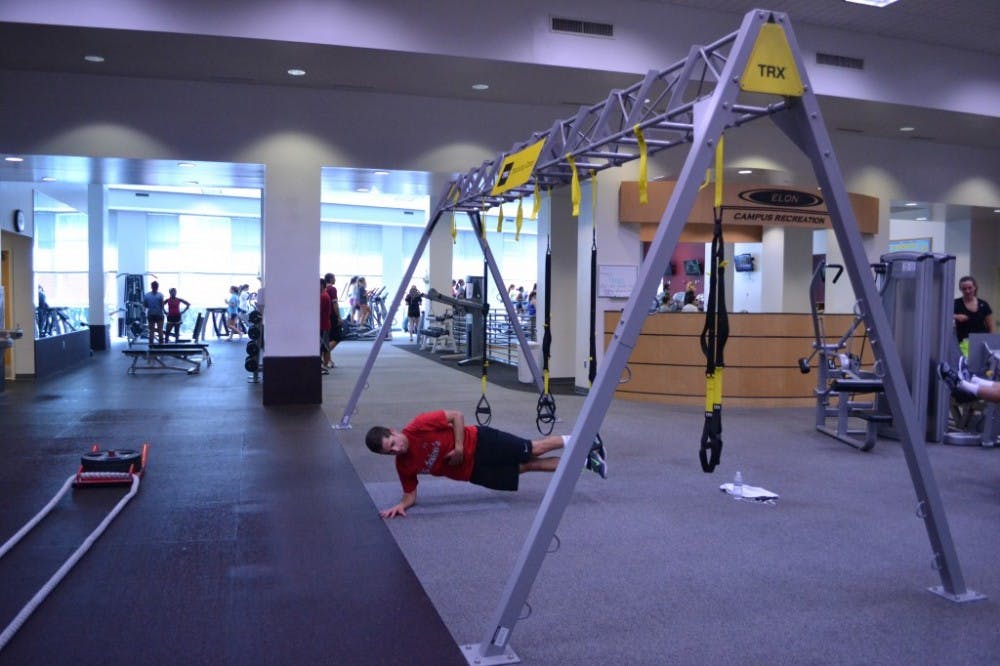In the animal kingdom, a “watering hole” is the main source of water in a given area. It’s where animals of any species come to physically soak up a necessary resource of life. For those who watched Animal Planet specials growing up, the watering hole was also where territorial displays between those species would take place—it’s the one place that encourages interaction. If Elon University had a watering hole, it would be the gym.
“You have your frat stars, your sorority girls, you have people that workout in pairs or three’s or fours. They all come in together, usually from 4:00-6:00,” said Iva Whitman, a Campus Recreation Trainer. “Most women come in solo but if they come in groups they’ll come in with two or three friends and go on the elliptical or do cardio—not so much with strength. Then you have serious people who come workout, which isn’t necessarily gender-specific, that do cross fit and actual weight training. Those people come at the times when it’s less crowded, and they know those times.”
It’s a game of strategy for students who choose to use the campus gym, as it’s become one of the most crowded common-areas at Elon. And that’s exactly the problem for some.
“There are more people at the gym trying to impress people than actually working out,” said Hailey Hamel. “That’s frustrating when fitness is your goal.”
As an Exercise Science major who prioritizes personal health, Hamel decided to move to a different watering hole 15 minutes away—Burlington’s, The Rush. This is a major move considering it’s the less convenient option and costs both gas and membership money. For Hamel and others though, these stipulations are worth it when compensating for the Elon gym downfalls.
“There’s more space to do circuit training and HIIT training, more free weights and more kettle bells,” Hamel said. “The biggest thing is they have more space. Instead of one type of machine for one body part, they have multiple. Even if there’s one taken for one body part, you can choose another one. Everything is just really new and up to date.”
Hamel is not the only one who’s discovered The Rush as a new source of fresh — workouts. A multitude of Elon students have made the same migration but interestingly enough, most have been women. Hamel reported that at least 15 girls from her Greek organization have also joined.
“I don’t want to see everyone I know when I workout and I don’t have to at the Rush,” said senior Kate Middleton. “There’s a stigma at Elon’s gym that guys workout downstairs and girls upstairs… I know some guys that want to use the elliptical but feel like they can’t because of that here. The Rush just doesn’t have any of that”
The divide between the upstairs and downstairs of Elon’s gym is an acknowledged cultural practice amongst gym-goers. Whether it’s because the lower level has more weights available or men don’t want to use ellipticals, as Middleton mentioned, the gender divide is unmistakable.
Sam Lubliner, a Campus Recreation employee, conducted research for a sociology class on this exact social habit at Elon’s gym and found that the divide spikes each gender’s motivation in one way or another.
“I interviewed about five or six people in the hopes of getting data that was similar and sound,” Lubliner said. “My second key informant said she prefers the downstairs because of the motivation it gives her and interestingly, my third key informant, a male friend who goes to the gym regularly, provided the same reason for working out upstairs. They both said that working out in an area that is majorly the opposite gender provides motivation.”
Is working out at Koury gym the new mating ritual? A typical watering-hole practice amongst species would ideally be to “checkout” the other—what they look like and what they’re doing. These behaviors can then either relax the environment or make it tense. Senior Dylan Reed said that, surprisingly, the majority of the “checking-out” that happens downstairs is between men.
“I’ll be lifting weights and realize after awhile that someone has been staring at me,” Reed said. “They watch the guys that seem to know what they’re doing or look like what they’ve been doing is working. Guys don’t really pay much attention to the girls that workout downstairs, it’s more each other.”
Regardless of the noticeable divides in the gym, the Campus Recreation Center works to support a holistic environment that includes both sexes.
“I understand the implicit bias when guys say girls should be comfortable working out downstairs,” said Tucker Kelly, a Campus Recreation employee. “But they really should.”
If Reed’s experience with the downstairs area of the gym is accurate, the male population of the Elon watering hole is more critical of one another than of females anyway. Despite this, females don’t want to run the risk of feeling judged.
“It’s one thing if you work out with a trainer, but when you go downstairs, where the guys are, it feels like they assume you don’t know what you’re doing,” Hamel said. “Like they don’t take you seriously because you’re a girl. Downstairs feels forbidden. It doesn’t bother me that much but it’s something you notice. And people at the Rush are more serious about their fitness because they’re paying for it so it really weeds out the people that are there to work out versus people there for a social purpose.”
One unifying factor of the Rush, according to Middleton and Hamel is that the entire center functions on one level, there’s no potential for divide — the same way it is in the wild.


